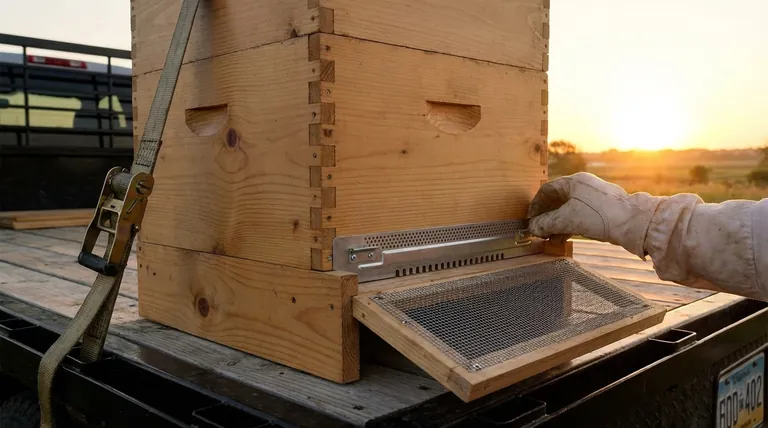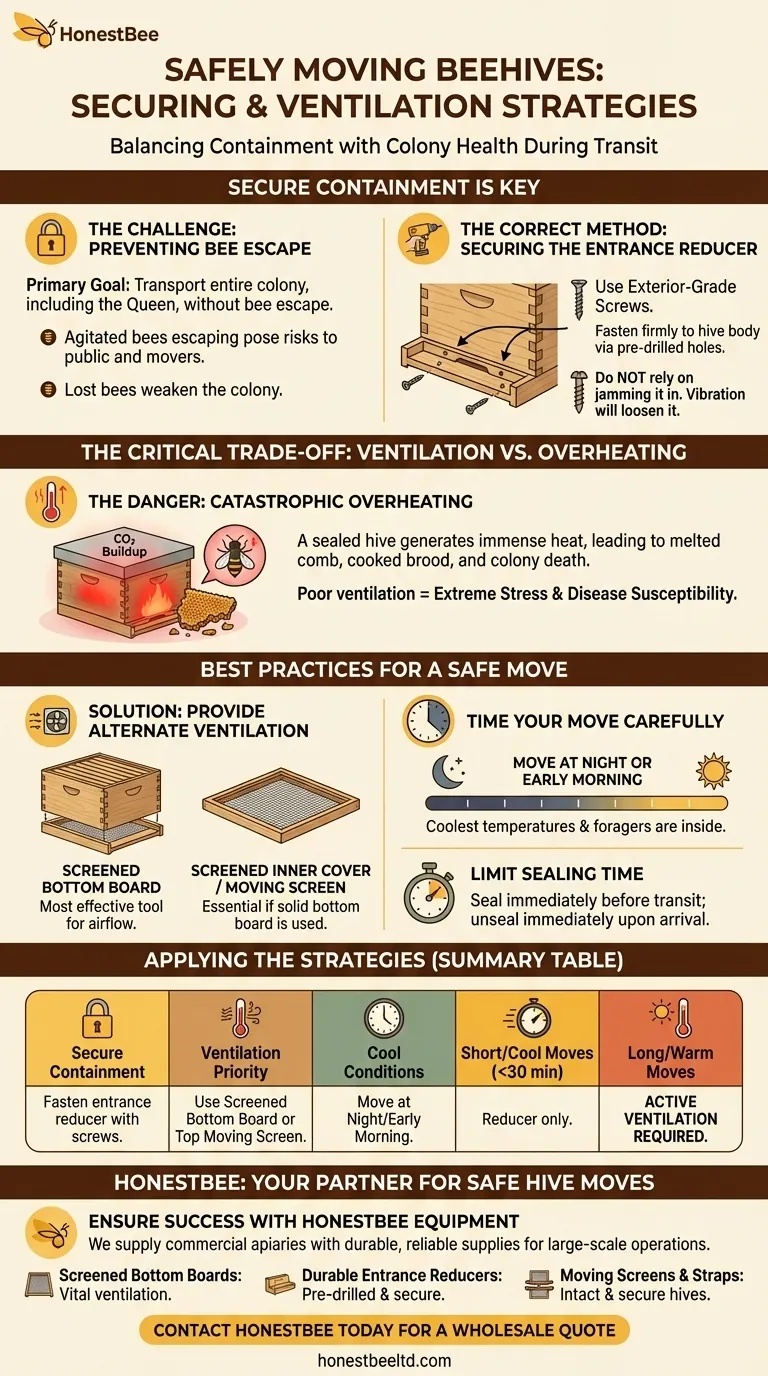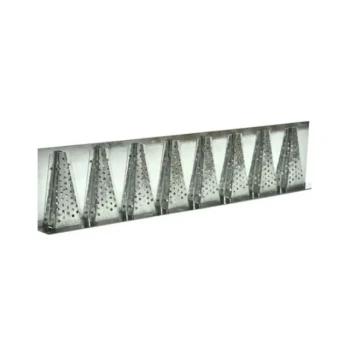To secure an entrance reducer when moving a hive, you must use screws to fasten it firmly to the hive body. Most reducers come with pre-drilled holes specifically for this purpose. This prevents the reducer from vibrating loose during transit, which would allow bees to escape.
Securing the entrance is a simple mechanical task, but the true challenge is managing the colony's health inside a sealed box. The primary risk during a hive move is not bee escape, but catastrophic overheating due to a lack of ventilation.

Why Containment is the First Priority
Preventing Bee Escape
A hive can contain tens of thousands of bees. If the entrance opens during transport, agitated bees will exit the hive, posing a significant risk to the mover and the public.
Securing all hive components, especially the entrance, is a fundamental safety measure. A few lost bees are expected, but a major escape can be dangerous and results in a weakened colony.
Protecting the Colony
The goal of the move is to transport the entire colony, including the queen, to a new location. Securing the entrance ensures the bees remain together as a cohesive unit.
Bees that escape in transit become disoriented, cannot return to their moving hive, and will ultimately perish.
The Correct Method for Securing the Reducer
Use the Provided Screw Holes
Your entrance reducer should have at least two holes, one on each side. These align with the solid wood of the hive's bottom board.
Do not simply jam the reducer into the opening. The vibrations of travel will almost certainly work it loose.
Fasten with Screws
Use an exterior-grade screw (like a deck screw) on each side to affix the reducer firmly to the hive body. The screw should be long enough to get a solid grip but not so long that it protrudes into the hive.
Ensure the reducer is snug against the bottom board with no gaps that bees could squeeze through.
Understanding the Critical Trade-offs
The Danger of Overheating
A beehive is a living superorganism that generates a tremendous amount of heat. When you seal the entrance, you cut off their primary source of ventilation.
On a warm day, or even a cool day in direct sun, a sealed hive can overheat in a surprisingly short time, leading to melted comb, cooked brood, and the death of the entire colony.
Stress and CO2 Buildup
Poor ventilation also leads to a rapid buildup of carbon dioxide. This, combined with the heat and vibrations of travel, places the colony under extreme stress.
A highly stressed colony is more susceptible to disease and may struggle to reorient itself after the move.
Best Practices for a Safe Move
Provide Alternate Ventilation
The safest way to move a hive is to seal the main entrance but provide ventilation elsewhere. A screened bottom board is the most common and effective tool for this.
If you do not have a screened bottom board, you can use a screened inner cover or a dedicated moving screen on top of the hive to allow for airflow.
Time Your Move Carefully
Always move bees at night or in the very early morning. This ensures two things: all the forager bees are back inside the hive, and ambient temperatures are at their lowest.
Moving during the coolest part of the day directly mitigates the risk of overheating.
Limit the Sealing Time
Only seal the hive immediately before you are ready to move it, and unseal it as soon as it is in its new location. The less time the bees are confined, the better.
How to Apply This to Your Move
- If you are moving a short distance (< 30 minutes) in cool, dark conditions: Simply screwing the entrance reducer in place is often sufficient, as the risk of overheating is low.
- If you are moving a longer distance or in any warm weather: Using a screened bottom board or a top moving screen for ventilation is not optional; it is critical for the colony's survival.
- If you have no ventilation options (e.g., solid bottom board only): You must limit the move to the coolest part of the night and keep the duration to an absolute minimum to avoid devastating losses.
By balancing secure containment with sufficient ventilation, you ensure your colony arrives at its new location healthy and ready to thrive.
Summary Table:
| Key Consideration | Action / Solution |
|---|---|
| Secure Containment | Fasten entrance reducer with exterior-grade screws using pre-drilled holes. |
| Prevent Overheating | Use a screened bottom board or top moving screen for ventilation. |
| Optimal Moving Time | Move the hive at night or in the early morning during cooler temperatures. |
| Distance & Conditions | Short, cool moves may only need a reducer. Long/warm moves require active ventilation. |
Ensure your next hive move is a success with the right equipment from HONESTBEE.
We understand that commercial apiaries and distributors need reliable, durable supplies for large-scale operations. A secure move is critical for protecting your investment and the health of your colonies.
HONESTBEE supplies beekeepers with essential moving equipment, including:
- Screened Bottom Boards: Provide vital ventilation to prevent overheating.
- Durable Entrance Reducers: Pre-drilled for easy and secure fastening.
- Moving Screens & Straps: Ensure hives stay intact and secure during transit.
Let us help you equip your operation with the wholesale-focused supplies you need for safe and efficient hive management.
Contact HONESTBEE today to discuss your equipment needs and request a wholesale quote.
Visual Guide

Related Products
- Beehive Entrance Reducer Guardian Metal Hive Entrance for Bees
- Multi-Functional Sliding Hive Entrance for Beekeeping
- Multi-Functional Rotary Hive Entrance Disc for Beekeeping
- Steel Round Disc Entrance Reducer for Flexzion Bee Hive Nuc Box Gate
- Professional Reversible Beehive Hive Entrance
People Also Ask
- What should be done after transferring frames to the new hive? Essential Steps for a Secure Colony
- What are the different entrance sizes for an 8 or 10-frame Langstroth hive? A Guide to Seasonal Management
- How can a Langstroth hive entrance be adjusted? Mimic Natural Bee Preferences for a Healthier Hive
- What size is the entrance hole in a native bee hive? The 13mm Standard for a Thriving Colony
- What are the features of the side with oblong holes in the entrance reducer? A Guide to Hive Defense & Health



















